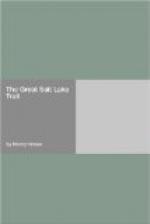[51] Beckwourth was a mulatto born in Virginia in 1798. He was of medium height, of strong muscular power, quick of apprehension, very active, and one of the greatest warriors the Crow Nation has ever produced. Around his neck he wore a perforated bullet, with a large oblong bead on each side of it, secured by a thread of sinew. He wore this amulet during the whole time he was chief of the Crows. He was one of the few honest Indian traders of whom history gives any account.
[52] Disfigurement of the body and dismemberment of the fingers, as an observance of mourning, was common among all Indian tribes. Sometimes upon the death of a warrior in battle his horse was cut and slashed, “to make him feel sorry for the loss of his master.”
[53] During the sessions of the Peace Commission at Fort Laramie in 1866, Beckwourth was sent on a mission to consult with the chiefs of the Crows. He was taken sick in one of their villages and died there, probably from old age rather than disease.
[54] The Sioux bury their dead on platforms erected seven or eight feet above the ground.
[55] For the best and most authentic collection of Indian Folk-lore, see George Bird Grinnel’s admirable volumes on the subject.
[56] Bancroft.
[57] This account is taken from files of the Denver newspapers published at the time of the massacre.
[58] Ouray did not profess the Catholic religion, despite his early training. He believed in the Ute god, and in a happy hunting-ground, and also in a bad place, where wicked people cannot meet their friends.
[59] There is more in this legend of a primitive, superstitious people, from an ethnological view of its details, than would be suspected at first. The story of the sacrifice and the medicine-man wrapping himself in the bloody hide of the buffalo, the use of the pine as fuel, and the prostration of the multitude, while communion is held with the Great Spirit, is the same ceremony that was observed by the Druids, and religious peoples before them. This peculiar offering of blood was common to the Indian who in the early years of the century occupied a portion of the territory east of the Mississippi. It will be remembered by the student of American history that when the war of 1812-1815 was pending, the celebrated Tecumseh and his brother, the Shawnee Prophet, called the tribes together, in order to induce them to side with the English. At that famous council they sacrificed a spotless red heifer on a high altar, and the medicine-man wrapped the bloody skin around him, while all the savages present prostrated themselves and communed with the Great Spirit to know what to do. The result was that Tecumseh’s plans were defeated, for the Indians were told by the Great Spirit to side with the Americans.
In the eleventh Book of the AEneid, Virgil relates the same observance on Mount Soracte, where there was a temple dedicated to Apollo, and a sacrifice made annually to the god, who represented the sun. Arruns in his prayer says:—




